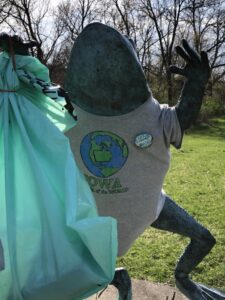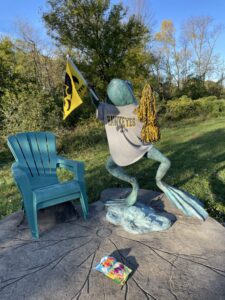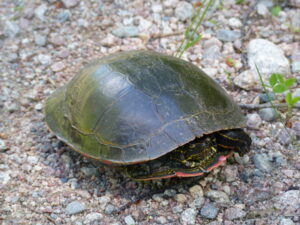by Winding Pathways | Aug 17, 2023 | (Sub)Urban Homesteading, Energy Efficiency, Labyrinths, Nature
Coralville’s Unitarian Universalist Society Members
Live What They Profess
In the middle of a worldwide heat wave that scientists declared resulted, in part, from human-caused climate change, we entered the campus of the Greenest Church in Iowa, the Unitarian Universalist Society in Coralville, Iowa. Feeling depressed by climate change news, the visit buoyed our spirits and gave us a glimmer of hope for the future of our planet.
One of the Unitarian Universalists’ principles is respect for the independent web of all existence of which we are a part of. The members of the Coralville church live the principle and others that form their core beliefs.
The Greenest Church in Iowa
As we turned into the Church campus, everything was softer and quieter. We drove past rows of photovoltaic solar cells. Just past them was a world of green. Nestled within native vegetation was a lovely contemplative labyrinth. A vegetated detention basin is both the home for pollinating insects and a place to catch stormwater, preventing it from scouring its way downhill.
We walked a delightful path circling the organization’s eight acres. Native flowers were alive with pollinators, and a children’s play area was meshed into nature. It’s almost as if this location were meant to be.
-

-
south facing solar panels
-

-
Water slows down as it percolates through the bioswale.
-

-
Families outside
On entering the building, the Church’s low ceiling entry opens into expansive spaces, an echo of Frank Lloyd Wright’s style. An immediate sense of calm and comfort enveloped us. Just beyond the cozy foyer, our eyes were drawn upward. East-facing windows framed an Iowa summer sky dotted with puffy clouds. Outside, deep green pines swayed in a gentle breeze. Members greeted us and Sally Hartman, chair of the Social Justice team, hosted us during the service. Worship leaders were engaging, the acoustics excellent, and the presence of the outdoors through the windows soothed us.
-

-
A lovely, open space
-

-
Visuals and audio enhanced the service.
-

-
Living the mission
How Did This Come to Be?
Depending on one’s perspective, this church and location have been in the making since the 1990s. More recently since 2013. Sally, also a member of the Iowa UU Witness Advocacy Network, and Kirk Witzberger, who served on leadership teams that developed and implemented the plans, explained. Over many decades, the Society recognized that even with renovations, the former Gilbert St. site in downtown Iowa City could not meet 21st Century needs. Different teams looked for new property. After an almost certain deal for another property fell through, a member happened to chat with a realtor who mentioned the current site. The Congregation voted overwhelmingly to buy and the couple who owned the land, former Peace Corps volunteers, were delighted to sell to an organization that respected the land.
Multiple meetings and myriad decisions followed. The result is a beautiful net zero building that the congregation shares with the community. The building burns no fossil fuel. Solar energy produces all its energy needs, including lighting, heating, and cooling.
Efficient and Flexible
The building includes a sanctuary, gathering spaces, offices, classrooms, and food service areas. Tucked into the property, it fits well. As attractive as its outdoor vegetation is, the building was well thought out. Just a few examples include:
- Efficient glass walls boost energy efficiency while allowing people inside to feel like they’re sitting in nature. We enjoyed watching clouds drift by during the service we attended.
- Flexible space can accommodate large groups of up to 600 or be compartmentalized into smaller, more intimate gathering places.
- All areas are easily accessible for folks with walking challenges. Even carpets are precisely flush with adjoining harder floors.
When we asked Kirk Witzberger, who was instrumental in the transition to this location, what the utility bill is he said, “We don’t have one. This is a zero net energy building…..it produces all its energy needs.” For members of an organization to live as lightly on the land as possible is impressive!
-

-
Free food and books.
-

-
Soft lighting directs footsteps.
-

-
Efficient east-facing windows let in light and bring a sense of nature inside.
-

-
Greenery softens the outside scape.
Living Other Principles
The Coralville Unitarian Universalist Society members live their commitments in other ways, too. Members take turns recycling compostable materials. When outside groups rent the space, they agree to a contract of sustainability – i.e. use only recyclable materials. The church is investigating how to be a “cool” refuge in summer and a “warm” refuge in winter. Further, members are researching ways they can offer a safe learning space for marginalized youth with activities like art and music. Members have held summer Nature Camps and environmentally-themed Trunk and Treats, and sponsored an environmental fair designed to raise awareness and action in caring for our world.
Inspiring Model
After touring the building and grounds we wondered why the model of the Unitarian Universalist Society isn’t more common in society. It should be. If people associated with all buildings everywhere did what they could to produce their energy needs through renewable sources the threat of climate change would be muted and our children could look forward to a cleaner and safer world.
Want to visit? The Church welcomes you. Details are on their website.
by Winding Pathways | Aug 10, 2023 | Mammals, Nature, Trees/Shrubs
Squirrels: Free Tree Planters
Our neighborhood squirrels proved they are the best tree planters.

We lost most of our mature trees in the 2020 Derecho.
An August 2020 derecho tore through Iowa pushing 140-mile-an-hour wind against trees and buildings. Trees by the hundreds of thousands tumbled to the ground. Winding Pathways wasn’t spared. We lost most of our firs, oaks, hickories, and cottonwoods. The devastation in nearby Faulkes Heritage Woods was even worse.
Almost immediately, shocked people took action. Government forestry departments, aided by tree planting nonprofits, and private citizens unleashed their shovels and planted thousands of trees. So did the squirrels. Well, not really. People planted trees.

Squirrels bury nuts in caches to retrieve them later.
Squirrels planted nuts and acorns.
Then three seasons of drought followed. Once planted, most trees were not tended as they need to be. So, many human-planted trees shriveled in the heat and dryness, while the nuts buried by squirrels sprouted and the new trees were flourishing.
But why?
We have theories. A human-planted tree seedling needs plenty of moisture to keep its trunk and new leaves hydrated. Sparse roots must pull water from the ground and send it upward. That’s a tough job in a wet year. Come drought it’s nearly impossible.
Squirrels did better. These industrious rodents don’t mean to create new trees. They’re simply storing nuts underground so they have enough fat and protein-rich food to tide them through winter. All they need to do is dig up a nut when hunger calls. Squirrels overfill their larder, burying more tasty nuts than they’ll ever need. Unfortunate squirrels are eaten by hawks, foxes, owls, or humans, but the nuts they’d buried remain patiently waiting for spring’s warmth to germinate.
Sprouting nuts grow roots able to pull scarce moisture from the soil and send it to new baby leaves poking through the ground.
As we walked through July 2023’s dry woods we sadly see human-planted trees shriveled up and dead, while nearby a new generation of tiny walnut, oak, and hickories is rising from nuts planted by industrious squirrels.
-

-
Newly planted trees need watering.
-

-
This squirrel planted walnut seedling sprouted just this year in spite of the drought.
Squirrels Don’t Plant All The Trees
Squirrels are the best friends of nut-bearing trees, but other tree species can’t rely on the furry rodents. Cottonwoods, for example, produce millions of seeds too tiny for squirrel food. So, the trees grow cottony fluff that floats seeds to distant places. If one lands in a patch of moist bear soil a fast-growing cottonwood sprouts. Maples have helicopter-like seeds that whirl a gig away from the parent to sprout a ways away.
Pity the poor Osage Orange tree that grows huge citrus-smelling balls containing hidden seeds. Many folks call them hedge apples. A tree must get its seeds away from its own shade. Squirrels do the job for oaks. The wind for cottonwoods. Massive mastodons once munched on Osage Orange hedge apples, wandered off, digested the pulp, and pooped out the seeds. When these massive elephants went extinct the tree lost its partner and saw its native range shrink from much of North America to a tiny spot down south.
Nature provides many ways for trees to reproduce and the results are often superior to what humans can do. We appreciate the squirrels that plant nuts many of which sprout into healthy native trees. Thanks, squirrels!
by Winding Pathways | Aug 3, 2023 | Garden/Yard, Nature, Wonderment
At the foot of East Post Road SE, just by Indian Creek is the frog statue that dons varied outfits each season and for many events. Take a look through the years. And visit our website for amphibian blogs.
The frog is serious about keeping healthy and helping after storms.
-

-
Masks and hand sanitizers did their jobs to help reduce the spread of SARS-CoV-2
-

-
Cleaning up after the 2020 Derecho.
Further into the year:
-

-
A green pot of gold.
-

-
Hoppy Easter!
-

-
Keeping it Clean
Middle of the Year is graduation, summer fun, and the Fourth of July with a loyal “Vandal” from Idaho!
-

-
Summertime and the livin’ is easy.
-

-
Frog And Vandal (UIdaho) posing.
-

-
Amphibian Safety Patrol…
-

-
Go Hawks!
-

-
Does this frog practice Reiki?
-

-
Coming for the candy.
Always a civic Duty Calls.
-

-
Research first.
We are “hopping” to add more photos as we walk by the ever-current and exciting Frog Statue. To learn about real frogs of Iowa visit the website link.
by Winding Pathways | Jul 27, 2023 | Nature, Travel/Columns, Trees
Always Something New To Learn
Although we’ve lived in Iowa for over 40 years, we never knew so much history crowded into a small town in the mid-1800s not long after settlement. Our visit to the Lewelling Quaker Museum in Salem, Iowa, brought us up to speed on history. The small museum tells a fascinating, little-known history that impacted people far beyond Iowa’s borders. They focus on three significant areas.
Quakers
The Museum’s formal name is the Lewelling Quaker Museum. These peaceful people moved to the area during the decades prior to the Civil War. Among their many beliefs was a strong aversion to slavery. Neighboring Missouri settlers owned slaves just 20 miles south of Salem.
-

-
Decorated in the era of the 1800s.
-

-
_Note Height Difference
-

-
Way to make music
The Underground Railroad
Salem area Quakers, joined by others of various faiths, were a significant part of the Underground Railroad that helped escaped slaves move north to legal safety in Canada. In the museum, located in an old home, we were able to enter the tiny crawl space beneath the kitchen where slaves hid from slave catchers. The process must have been scary for both slaves and those who helped them. Captured slaves were returned to their owner for likely punishment and continued to live in bondage. Whites who helped risked arrest and incarceration. Yet, the Underground railroad persisted and helped many people gain freedom.
-

-
Salem was a major depot.
-

-
A rug and kitchen table covered the closed trap door.
Fruit
The Lewelling Family were nursery people who cultivated and sold fruit trees. They developed several productive varieties of cherries and apples. In the early days of the Oregon Trail travel fever infected the Lewellings. They modified a wagon to hold tiny fruit tree slips and made the arduous trek over the Great Plains and mountains all the way to the Willamette Valley. Most of the baby trees survived the trip and were used to start the Pacific Northwest’s famed fruit industry. People enjoy different fruits and apple varieties to this day in part because of the families that carried the tiny fruit slips west.

18″ thick walls.
The volunteer-operated Lewelling Quaker Museum is open for tours Sunday afternoons from 1-4 pm May through September and by appointment at other times and dates. We found our visit fascinating and encourage others to go. Salem is located a few miles south of Mount Pleasant, Iowa, in the SE corner of the state. For information check lewelling.org.
by Winding Pathways | Jul 20, 2023 | Reflections/Profiles, Uncategorized, Weeds
Wisdom From “Johnny Appleseed” of Prairie Plants
“Weeds are mother nature’s stitches,” prairie restorationist Corliss “Jock” Ingels told us years ago.
“If you badly cut yourself, a physician stitches the wound closed so it can heal. If you bare the ground, weeds quickly sprout, shading the soil with foliage and filling it with roots. Weeds reduce erosion until more permanent plants take hold,” he proclaimed.

Even rag weed has a purpose. Birds love the seeds.
On a hot summer morning, we pedaled along the Grant Wood Trail, seeing mother nature’s stitches alongside the new pavement. Recently the popular bicycle trail was paved. Machines bared the soil at the edge of the pavement that’s now covered with bright yellow trefoil, crown and purple vetch, golden dandelions, white spurge, sweet clover, ragweed, and poison hemlock. All are so-called invasive weeds, but they’re providing a service by holding the soil and giving homes to trailside wildlife until more “desirable” plants establish. Some of those pioneering weeds sported an array of bright flowers that made our morning ride delightful.
Beyond Human Centric
Weeds have a purpose, but must a plant or animal need to have a “human-centric” perspective?
The night before our bike ride we sat on our back deck with Neil and Renata Bernstein. He’s a recently retired biology professor and remarked that sometimes people ask what purpose a particular plant or animal has.
Purpose! Must plants and animals have a purpose from a human perspective?

Easily recycled cans become trash.
Dr. Bernstein sometimes responds to these questions by saying, “What’s the purpose of people?” Indeed, our observations are that modern humans have forced out original people from their lands. We have done a great deal of harm by polluting the air, siphoning off life-giving water to maintain green grass, and stripping the land of topsoil, precious metals, and crystals. We greedily take a resource, convert it to our own purpose, then throw it away. “What’s the purpose of people?”
More to Purpose Than Our Perspective

We can learn much from turtles.
Some living things certainly have a great purpose. Without wheat, cattle, corn, penicillin mold, lumber, trees, and thousands of other plants and animals we couldn’t live. Others may seem to have a negative purpose. Think disease-causing microbes, poison ivy, ragweed that spews allergic pollen into the air, mosquitoes, and a host of other creatures that cause human misery. To view them negatively is human-centric.
The vast majority of living things neither produce tangible benefits nor problems for people. Like turtles, they simply live. Probably they have a valuable ecological role that may not be obvious but they are here. They have a right to be here whether or not they provide human impact. As we have learned over millennia, different plants and animals, offer benefits to us. We simply have to observe and incorporate.
To Everything…There is a Purpose
Every living thing has a purpose in the great scheme of things that people barely understand.
So, as we cycle along, we doff our bike helmets to the diversity of life we pass and silently thank them for sharing the world with us.



































